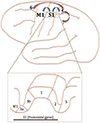Understanding the role of the primary somatosensory cortex: Opportunities for rehabilitation
- PMID: 26164474
- PMCID: PMC4904790
- DOI: 10.1016/j.neuropsychologia.2015.07.007
Understanding the role of the primary somatosensory cortex: Opportunities for rehabilitation
Abstract
Emerging evidence indicates impairments in somatosensory function may be a major contributor to motor dysfunction associated with neurologic injury or disorders. However, the neuroanatomical substrates underlying the connection between aberrant sensory input and ineffective motor output are still under investigation. The primary somatosensory cortex (S1) plays a critical role in processing afferent somatosensory input and contributes to the integration of sensory and motor signals necessary for skilled movement. Neuroimaging and neurostimulation approaches provide unique opportunities to non-invasively study S1 structure and function including connectivity with other cortical regions. These research techniques have begun to illuminate casual contributions of abnormal S1 activity and connectivity to motor dysfunction and poorer recovery of motor function in neurologic patient populations. This review synthesizes recent evidence illustrating the role of S1 in motor control, motor learning and functional recovery with an emphasis on how information from these investigations may be exploited to inform stroke rehabilitation to reduce motor dysfunction and improve therapeutic outcomes.
Keywords: Motor control; Motor learning; Neuroimaging; Noninvasive brain stimulation; Primary somatosensory cortex; Rehabilitation; Stroke.
Copyright © 2015 Elsevier Ltd. All rights reserved.
Figures


Similar articles
-
Stimulus-driven changes in sensorimotor behavior and neuronal functional connectivity application to brain-machine interfaces and neurorehabilitation.Prog Brain Res. 2011;192:83-102. doi: 10.1016/B978-0-444-53355-5.00006-3. Prog Brain Res. 2011. PMID: 21763520 Review.
-
Modulation of excitability in human primary somatosensory and motor cortex by paired associative stimulation targeting the primary somatosensory cortex.Eur J Neurosci. 2011 Oct;34(8):1292-300. doi: 10.1111/j.1460-9568.2011.07849.x. Epub 2011 Oct 6. Eur J Neurosci. 2011. PMID: 21978102
-
Beyond the silence: bilateral somatosensory stimulation enhances skilled movement quality and neural density in intact behaving rats.Behav Brain Res. 2013 Sep 15;253:78-89. doi: 10.1016/j.bbr.2013.07.022. Epub 2013 Jul 16. Behav Brain Res. 2013. PMID: 23871611
-
Paired-pulse transcranial magnetic stimulation of primary somatosensory cortex differentially modulates perception and sensorimotor transformations.Neuroscience. 2008 Nov 19;157(2):424-31. doi: 10.1016/j.neuroscience.2008.09.008. Epub 2008 Sep 10. Neuroscience. 2008. PMID: 18838111
-
Role of the somatosensory system in primary dystonia.Mov Disord. 2003 Jun;18(6):605-22. doi: 10.1002/mds.10398. Mov Disord. 2003. PMID: 12784263 Review.
Cited by
-
Abnormal corpus callosum induced by diabetes impairs sensorimotor connectivity in patients after acute stroke.Eur Radiol. 2019 Jan;29(1):115-123. doi: 10.1007/s00330-018-5576-y. Epub 2018 Jun 20. Eur Radiol. 2019. PMID: 29926208
-
A review of brain regions and associated post-concussion symptoms.Front Neurol. 2023 Aug 3;14:1136367. doi: 10.3389/fneur.2023.1136367. eCollection 2023. Front Neurol. 2023. PMID: 37602240 Free PMC article. Review.
-
Transcranial direct current stimulation enhances foot sole somatosensation when standing in older adults.Exp Brain Res. 2018 Mar;236(3):795-802. doi: 10.1007/s00221-018-5178-6. Epub 2018 Jan 15. Exp Brain Res. 2018. PMID: 29335751 Free PMC article. Clinical Trial.
-
Disrupted callosal connectivity underlies long-lasting sensory-motor deficits in an NMDA receptor antibody encephalitis mouse model.J Clin Invest. 2024 Dec 31;135(5):e173493. doi: 10.1172/JCI173493. J Clin Invest. 2024. PMID: 39739422 Free PMC article.
-
Real-time functional magnetic resonance imaging neurofeedback in motor neurorehabilitation.Curr Opin Neurol. 2016 Aug;29(4):412-8. doi: 10.1097/WCO.0000000000000340. Curr Opin Neurol. 2016. PMID: 27213774 Free PMC article. Review.
References
-
- Andersen RA, Snyder LH, Bradley DC, Xing J. Multimodal representation of space in the posterior parietal cortex and its use in planning movements. Annu. Rev. Neurosci. 1997;20:303–330. - PubMed
-
- Becke A, Muller N, Vellage A, Schoenfeld MA, Hopf JM. Neural sources of visual working memory maintenance in human parietal and ventral extra-striate visual cortex. NeuroImage. 2015;110:78–86. - PubMed
-
- Blakemore SJ, Wolpert DM, Frith CD. Central cancellation of self-produced tickle sensation. Nat. Neurosci. 1998;1:635–640. - PubMed
Publication types
MeSH terms
Grants and funding
LinkOut - more resources
Full Text Sources
Other Literature Sources
Medical

